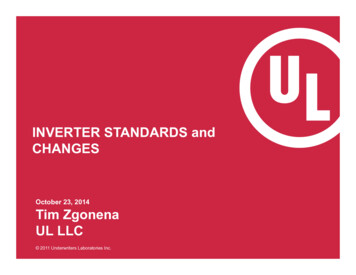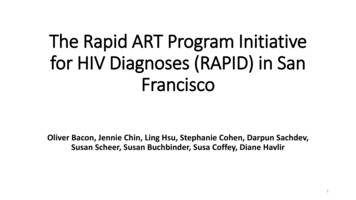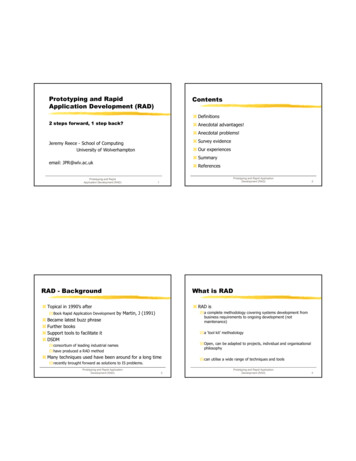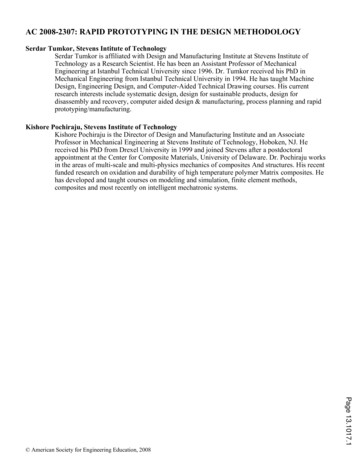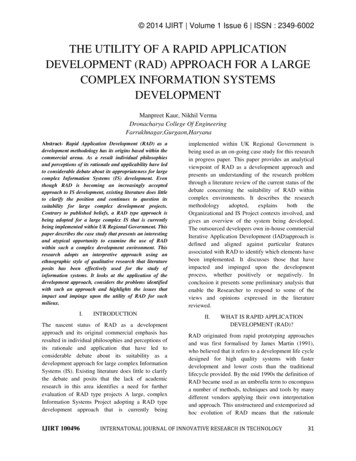
Transcription
2014 IJIRT Volume 1 Issue 6 ISSN : 2349-6002THE UTILITY OF A RAPID APPLICATIONDEVELOPMENT (RAD) APPROACH FOR A LARGECOMPLEX INFORMATION SYSTEMSDEVELOPMENTManpreet Kaur, Nikhil VermaDronacharya College Of EngineeringFarrukhnagar,Gurgaon,HaryanaAbstract- Rapid Application Development (RAD) as adevelopment methodology has its origins based within thecommercial arena. As a result individual philosophiesand perceptions of its rationale and applicability have ledto considerable debate about its appropriateness for largecomplex Information Systems (IS) development. Eventhough RAD is becoming an increasingly acceptedapproach to IS development, existing literature does littleto clarify the position and continues to question itssuitability for large complex development projects.Contrary to published beliefs, a RAD type approach isbeing adopted for a large complex IS that is currentlybeing implemented within UK Regional Government. Thispaper describes the case study that presents an interestingand atypical opportunity to examine the use of RADwithin such a complex development environment. Thisresearch adopts an interpretive approach using anethnographic style of qualitative research that literatureposits has been effectively used for the study ofinformation systems. It looks at the application of thedevelopment approach, considers the problems identifiedwith such an approach and highlights the issues thatimpact and impinge upon the utility of RAD for suchmilieux.I.INTRODUCTIONThe nascent status of RAD as a developmentapproach and its original commercial emphasis hasresulted in individual philosophies and perceptions ofits rationale and application that have led toconsiderable debate about its suitability as adevelopment approach for large complex InformationSystems (IS). Existing literature does little to clarifythe debate and posits that the lack of academicresearch in this area identifies a need for furtherevaluation of RAD type projects A large, complexInformation Systems Project adopting a RAD typedevelopment approach that is currently beingIJIRT 100496implemented within UK Regional Government isbeing used as an on-going case study for this researchin progress paper. This paper provides an analyticalviewpoint of RAD as a development approach andpresents an understanding of the research problemthrough a literature review of the current status of thedebate concerning the suitability of RAD withincomplex environments. It describes the tional and IS Project contexts involved, andgives an overview of the system being developed.The outsourced developers own in-house commercialIterative Application Development (IAD)approach isdefined and aligned against particular featuresassociated with RAD to identify which elements havebeen implemented. It discusses those that haveimpacted and impinged upon the developmentprocess, whether positively or negatively. Inconclusion it presents some preliminary analysis thatenable the Researcher to respond to some of theviews and opinions expressed in the literaturereviewed.II.WHAT IS RAPID APPLICATIONDEVELOPMENT (RAD)?RAD originated from rapid prototyping approachesand was first formalised by James Martin (1991),who believed that it refers to a development life cycledesigned for high quality systems with fasterdevelopment and lower costs than the traditionallifecycle provided. By the mid 1990s the definition ofRAD became used as an umbrella term to encompassa number of methods, techniques and tools by manydifferent vendors applying their own interpretationand approach. This unstructured and extemporized adhoc evolution of RAD means that the rationaleINTERNATONAL JOURNAL OF INNOVATIVE RESEARCH IN TECHNOLOGY31
2014 IJIRT Volume 1 Issue 6 ISSN : 2349-6002behind its use is not always clear. It is perceived asan IS system methodology, a method for developersto change their development processes or as RADtools to improve development capabilities. (BeynonDavies 1999). Literature reports that RAD centres onprototyping and user involvement where the analysis,design, build and test phases of the development lifecycle are compressed into a sequence of short,iterative development cycles. This was seen as aremedy to perceived flaws with the traditionallifecycle because the iterative approach encourageseffectiveness and self-correcting as each increment isrefined and improved. It necessitates thecollaboration of small and diverse teams ofdevelopers, end users and other stakeholders (Martin1991, Tudhope 2001, Beynon-Davies 1996, Elliott1997). The public domain RAD standard is theDSDM (Dynamic Systems Development Method, seesection 9) but the specific method described in thecontext of this paper is Iterative ApplicationDevelopment(IAD) a vendor specific method (Described inSection 3).RAD projects are sometimes distinguishedin terms of intensive and non-intensive forms. A nointensive approach refers to projects where systemdevelopment is spread over a number of monthsinvolving incremental delivery compared to theintensive RAD where project personnel are closetedaway to achieve set objectives with a 3 - 6 weektimeframe (Beynon-Davies 1999). The case studyconcerns a non-intensive approach that is consideredto be more adaptable for larger projects becausedevelopment can be organized into separate blocksfor incremental development and phased delivery.III.ITERATIVE APPLICATIONDEVELOPMENT METHODOLOGIESThis section describes the development method used,the Researcher’s aim is to emphasize aspects of thedevelopment process that are distinctive as far asRAD is concerned not to focus on the product.The developers adopted their own in-housecommercial Iterative Application Development(IAD) approach to promote a controlled, structuredbut flexible development methodology aimed atproviding incremental delivery. This involved aseries of time-boxed mini iterations and a number ofsoftware ‘release’ and test iterations to provideflexibility to meet the recognized volatile needs ofIJIRT 100496the business environment. They believe thismethodology offers all the main benefits of a RADtype approach and is suited to the uncertainty of, andcontinually changing business requirements. IAD,like RAD, involves prototyping and iterative deliverybut without the problems of lack of rigour, creepingscope and overrun that are perceived as associatedwith RAD and an iterative development life cycle. Itssimilarity is extended to using the same main featuresi.e. JAD (Joint ApplicationDesign) workshops, time-boxing, prototyping,intensive user involvement, iterative developmentand incremental delivery, which they maintain areincreasingly used for system functionalitydevelopment. The developers believe that a majorbenefit of an iterative approach to development isthat it affords early visibility of the system beingdeveloped. Thus early validation of the system by theusers and the business analysts provides theflexibility to incorporate user feedback and handleany new or changing requirements within the volatilebusiness environment – a key goal of the RADapproach.IV.RAD - THE DEBATEAs a systems development approach RAD has bothcritics and supporters whose opinions, in some cases,are fundamental to individual philosophies andperceptions of its rationale. Existing literatureexposes particular themes of discussion within theRAD arena and a prominent area of debate concernsthe scalability of RAD across large and complexenvironments. Although the lack of provenance isreflected by the limited availability of publishedmaterial, there is substantial reportingof its application and considerable debate about itsappropriateness for different types and sizes ofsystems development. (Osborn 1995, Beynon-Davies1999, 2000). RADs origins as a development processcan be placed more within a commercialdevelopment arena than an academic one andliterature considers it more appropriate for small tomedium simple, highly interactive developmentprojects rather than for environments that are alsocomputationally complex such as the case studyinvolved. It is further thought that its success islinked to the project management approach, level ofmanagement commitment, degree of end-userinvolvement and the ability of the team to makeINTERNATONAL JOURNAL OF INNOVATIVE RESEARCH IN TECHNOLOGY32
2014 IJIRT Volume 1 Issue 6 ISSN : 2349-6002fastauthoritative decisions (Beynon-Davies 1998). l and managerial changes becausepeople are required to behave in a different way thanin themore structured traditional environments.Consequently without radical shifts in organizationalattitudes and structures and peoples’ mindsets manyprojects may fail because the change to newmethodologies, methods and techniques did not fitwithin the culture (Hirschberg 1998, McConnell1996). Hence the potential of a RAD developmentand delivery approach to meet information systemsrequirements in uncertain and volatile ents is questioned. Critics advocate that theneed for high levels of user involvement, stakeholdercollaboration, lack of project control and rigour aremajor issues to its success (Martin 1991, Osborn1995, Beynon-Davies 1996, 2000, Elliott 1997, Cross1998, Boehm 1999, Highsmith 2000).V.regulatory control mechanisms that undergocontinual change.Development was outsourced to a commercialcompany who were provided with a requirementsspecification of the core processes that would formthe basis of development activities. This was drawnup from an analysis of the existing ‘As – Is’ legacysystem and described a high level view of theGeneric Process core activities for the replacement‘To – Be’ system. Although outsourced the projectenvironment remains within a central location(Cardiff) where both the clients and developers areco-located on the same site throughout the projectduration. Consequently both public and commercialcultures co-exist within the same environment. Theproject structure comprises of a management projectboard and teams of project workers with a predefined reporting structure. Teams are both integratedacross the two cultures and are subject/specialistspecific according to need.ORGANISATIONAL CONTEXTIn 1999 under the UK Government’s Devolutionlegislation a UK Regional Government departmenttook on the devolved functions formally carried outby the Welsh Office. It became responsible formanaging the expenditure of EC grants and subsidiesto customers through a number of CommonAgricultural Policy (CAP) schemes across the region.Headquarters is centrally located and operations runfrom a number of Divisional and Area Offices actingas powerhouses of management functions. Thecustomer base consists of farmers, farmingbusinesses, and other citizens. The case studyconcerns the development of the new IT systemaimed at improving the current effectiveness andefficiency of the agricultural grants and subsidyadministration. The system moves away from theformer discrete individual scheme administrationprocesses towards a Generic Process that integratesthe core processing of the common activities of theseparate schemes. Each scheme details the EC rulesand conditions that apply, however the schemes donot exist independently of each other, but acquiesceto a ‘network’ of complex interdependentrelationships that are also individually dependent onspecific payment windows within an annual cycle.All payments must conform to EC legislation and ECIJIRT 100496VI.PROJECT CONTEXTThe project was initially planned for a period of 2years, March 2001 to March 2003 and divided into 4sequential development stages. Stage 1 l.Stages 2, 3, & 4 consisted of iterations of IADdevelopment cycles, testing and acceptance. Howeveran outbreak of the Foot & Mouth Disease affectingthe agricultural industry early 2001 impededdevelopment work as key project personnel were reassigned to deal with it. Consequently the Projectwas extended into a 3rd year and is still ongoing.Access to the project environment was granted byboth client and development Project Managers andpermission given to approach all project personnel.The Project is described as large in terms of finance –an initial estimate of 10m; size of the projectteam – a core team of 50 ; the volume of businessrules developed aligned to business processes –currently in excess of 4,000; and the extent of itsagricultural customer base throughout Wales.VII.RESEARCH METHODOLOGYThe Researcher adopted an interpretive stance asadvocated by Walsham (1997) aimed at producing anunderstanding of both the context of the IS and theprocess in which the IS influences and is influencedby its context. Ethnography was selected as a style ofINTERNATONAL JOURNAL OF INNOVATIVE RESEARCH IN TECHNOLOGY33
2014 IJIRT Volume 1 Issue 6 ISSN : 2349-6002interpretative qualitative research for intensive datacollection that allows a rich and deep interpretation(Myers 1999, Orlikowski and Baroudi 1989). Itssuitability is reflected by its association with other ISdevelopment projects (Loftland and Loftland 1984,Strauss and Corbin 1990, Gill and Johnson 1991,Beynon-Davies 1997, Johnson and Duberley 2000).Secondary research reflects two levels. Firstly, an indepth exploration and analysis of existingliteraturefrom both academic and practitioner perspectives topresent a foundation for anunderstanding of thecurrent situation in the field of Rapid ApplicationDevelopment. Secondly, anexamination of existingproject documents, discourse and artefacts. A CaseStudy database is being created using QSRNUD*IST Vivo (Nvivo), a qualitative softwareproduct to store and analyse the range of qualitativedata collected (Myers 1999, Yin 2003). Initial dataanalysis was driven by the data rather than theResearcher and concerned ‘open coding’ thatinvolved content analysis where data were analysedand categorised into themes. Further investigationnecessitated establishing how these categories mightinter-relate and link into sub-categories that reflectthe associated dimensions and conditions. This iscommonly known as axial coding and was used touncover the relationships within the categories.Strauss and Corbin (1990) substantiate theimportance of understanding the relationship betweenstructure and process, which they believe areinextricably linked, in order to comprehend thephenomenon being studied. The Researcherrecognises that as both the IS development projectand this research are being fundedby the Regional Government involved, the datacollected may be affected. Additionally, to deal withpotential ethical problems confirmation was soughtfrom the Project Board at the onset that participantconfidentiality would be maintained, and thatanalysis from the information gathered would not beused out of context by them.VIII.HIGH LEVEL SYSTEM DESCRIPTIONCustomers apply for CAP grants and subsidies bysubmitting completed scheme specific applicationclaim forms. Before being archived the ‘data set’ ofthat claim form are captured through a scanning datacapture process and stored in a database. A BusinessRules Engine contains the CAP schemes and EUIJIRT 100496regulations as specific business logic rules that arelaunched dynamically during run time enablingautomated workflow processes to apply to the genericprocesses i.e. acceptance, validation, calculatepayment, and any failure procedures against eachcustomer’s application claim form. A ‘perfect claim’without errors or anomalies that satisfies all therelevant business rules and workflow steps is passedthrough the system for ’payment processing’ via aninterface to the current finance systems’ AccountingMatrix without manual intervention. However, ‘datasets’ of forms that fail are placed into a process workqueue within the workflow procedure to await theattention of the team of multi-skilled users withspecific scheme expertise. Once resolved, the ‘dataset’ is returned to workflow process for furtherprocessing.IX.CASE STUDY PROJECT AND THEAPPLICATION OF A RAD APPROACHThis section describes aspects of the context of the ISdevelopment project. It also describes criticalelements of the development work important to theResearcher’s explication of RAD.Set out below in Table 1 are the 9 fundamentalprinciples that the DSDM Consortium haveestablished constitute a RAD type methodology.These were used to determine the application of aRAD-ish approach across on-going development ofthe Case Study Project. There is significant evidencethat the first 8 of the principles that constitute a RADprocess occurred during the Project, howeveralthough co-operation was achieved with the majorityof stakeholders, a serious constraint on the RADdevelopment process was the inflexibility of the ECas a major stakeholder. Conformity to EC legislationand regulations where the ’fit for purpose’requirement reflected almost 98% of business needsimpacted on the time-boxing concept and the descoping element of a RAD development process thatproved difficult to achieve. As the literature suggestsa successful RAD approach necessitates cultural andmanagerial changes(Hirschberg 1998, McConnell 1996). In thisparticular case study a radical shift in the mindsets of‘organisational’ people was needed to promote theGeneric Process model. Evidence exposes thedifficulty that these people had in moving away fromtheir previous ‘silo’ attitude to buying into theINTERNATONAL JOURNAL OF INNOVATIVE RESEARCH IN TECHNOLOGY34
2014 IJIRT Volume 1 Issue 6 ISSN : 2349-6002Generic Process concept. This was highlighted bytheir inability to prioritise scheme development workas each Scheme Manager believed theirs wasparamount. The inability to make empowereddecisions about business needs was a key concern forthe developers who needed to meet time-boxeddevelopment deadlines. It is felt that this issue islinked to the identified need for strong projectmanagement with a RAD approach. Analysis ofviews from both the Development Team and theclient Project Team indicate that this was a ProjectManagement issue that should have been resolvedthrough direct supervision of those concerned toprioritise business needs. However an influencingfactor reveals that the Scheme Mangers are deemedto ‘own’ their scheme business processes and as suchdid not respond to the level of Project Managementsupervision that was applied. Consequently, ProjectManagement is viewed as reactive rather thanproactive and considered weak since the authorityexerted was not sufficient or effective enough tohandle the impact this issue had on initialdevelopment delay. Conversely, Project Managementbelieve that this problem reflects the ‘civil servant’culture inherent in government environments wheredecision making is deferred to a higher authority inresponse to a perceived ‘blame culture’ environment.The Researcher believes that low visibility of projectmanagement rather the perceived lack of projectcontrol may be the issue. Perhaps the most notableargument being addressed is the view expressed inthe literature that RAD is unsuitable for complex ISdevelopment. The complexity of this IS system isreflected by the CAP schemes that are notindependent of each other, but acquiesce to a‘network’ of highly complicated interdependentrelationships that are also individually dependent onspecific payment windows within an annual cycleand subject to continual change. These difficultieshave been successfully addressed through the use ofbusiness rules logic. Each business rule contains anaction that gets performed whena condition is met. In other words business rules areconcerned exclusively with a business action thatneeds to be performed and the circumstances thattrigger that action. In this way a business rulerepresents a part or parts of a process of a particularscheme that satisfies a specific business need. Thedevelopers decompose the business rules intoIJIRT 100496individual statements that are underpinned by ‘Java’coding. These are then saved and stored for re-use toprovide a flexibly where the business rules can bemodified by the organisations people without theneed to alter the Java coding. This has enabledappropriate employees to meet changing and newbusiness needs, a RAD concept, and conform to theEC legislation and EC regulatory controlmechanisms. However, this only accommodatessimple straightforward regulatory changes such asmodifying payment dates or percentage values setwithin a business rule. For more complex interwovenchanges whose impact cascades across a number ofinterrelated schemes the need still exists for specialistIT knowledge that the organisations people do nothave. Consequently this creates a heavy reliance onthe developers that is seen as a potential problem.X.CONCLUSIONThe research question concerns the utility of using aRAD approach for a large complex IS development.Contrary to the published beliefs, a RAD typeapproach has been adopted for a large complex ISthat is currently being implemented within UKRegional Government even though existing literaturecontinues to question its suitability for this type ofdevelopment environment. The case study issignificant in that it presents an atypical and valuableopportunity to provide an analytical insight of RADtype development approach within such a complexenvironment, and thus respond to the researchquestion and views expressed in the literature.Additionally, it addresses the identified lack ofacademic research in this field whilst adding to thebody of existing knowledge. Evidence suggests somedistinct areas where the RAD approach has beensuccessful. Most notable is the iterative nature of thedesign, build and integrated test phases of thedevelopment life cycle that enabled the system toaccommodate the complexities and interwovenrelationships inherent in theCAP schemes. This in conjunction with theapplication of business rules logic provides aflexibility for the system to evolve inline with EClegislation and regulatory controls that is seen as acritical factor in its perceived success. This is akeystone goal of a RAD approach i.e. to nments.INTERNATONAL JOURNAL OF INNOVATIVE RESEARCH IN TECHNOLOGY35
2014 IJIRT Volume 1 Issue 6 ISSN : 2349-6002The JAD workshops, a main feature of RAD, thatwere used for requirements elicitation were ofparticular importance in the success of thisdevelopment approach. They were responsible fordrawing out the crucial business understanding andperception that was not documented but only existedas tacit knowledge of individual scheme experts. Thiscoupled with the iterative design, build and testingcycles is seen as a critical success factor in meetingthe degree of conformity required by the EC.A major success factor is that this project is perceivedas a re-usable investment that will provide futurebenefits since the system itself has potential for widerapplications across similar arenas within UKRegional Government.However there are also areas where the RADapproach has been unsuccessful. Strong effectivemanagement is considered key to the success ofRAD. However, it is evident that ProjectManagement here was ineffective in managing thecultural and managerial changes necessary for suchan approach. Evidence exposes the difficultyexperienced by key people in shifting away from a‘silo’ attitude to buying into the Generic Processconcept that was counter cultural and hence difficultfor them to accept. Considerable delay resulted fromtheir inability to make empowered decisions that, it isfelt, could have been controlled through strongermanagement supervision and pressure exerted. Anexternal influence outside the projects controlprovided a further serious constraint on the RADdevelopment process. The inflexibility of a majorstakeholder, the EC, whose rigidity necessitated highlevels of conformity to business needs that impactedseverely on development deadlines. Althoughbusiness rules logic is successful in meetingstraightforward system changes, more complexchanges require involve a software solution. Thus theneed still exists for specialist IT knowledge that theorganisation’s people do not have. Consequently thiscreates a heavy reliance on the developers that is seenas a potential problem once the project has reachedcompletion. To date, both the clients and thedevelopers believe that the RAD type developmentapproach has been successful for this case studydevelopment environment, particularly in light of itsevolving and volatile nature, and suggest that had atraditional ‘Waterfall’ development approach beenadopted the project would have been cancelled earlyIJIRT 100496during second year. It is believed that this researchhas provided a useful starting point to critique theutility of using a RAD type development approachfor large complex IS development and the Researcherexpects to continue research and analysis to clarifythis issue further.REFERENCES[1] Beynon-Davies, P, Mackay, H, Slack, R &Tudhope, D (1996), Rapid ApplicationsDevelopment: the future for business systemsdevelopment?, Published proceedings of BIT96Conference,November7th,ManchesterMetropolitan University,[2] Beynon-Davies, P (1997),‘Ethnography andInformation Systems Development: Ethnographyof, for and within IS development’, Informationand Software Technology, vol. 39, pp. 531-540.Beynon-Davies, P (1998), Rapid ApplicationsDevelopment (RAD), Briefing Paper, KaneThompson Centre, University of Glamorgan.[3] Beynon-Davies, P, Carne, C, Mackay, H &Tudhope, D (1999), Rapid applicationdevelopment (RAD): an empirical review,European Journal of Information Systems, vol.8, pp. 211-223[4] Beynon-Davies, P, Mackay, H & Tudhope, D(2000),‘It’s lots of bits of paper and ticks andpost-it notes and . a case study of a RADproject’, Information Systems Journal, vol. 10,pp. 195-216.[5] Boehm, B (1999), ‘Making RAD work for yourProject’, IEEE Computer, March, pp113-117.[6] Cross, SE (1998), ‘Toward Disciplined RapidApplication Development’, Software ed.html[7] DSDM Consortium, (1995), Dynamic SystemsDevelopmentMethod,viewed14/02/2002. http://www.dsdmna.org/en/about/principles.asp [8] Elliott,E(1997),RapidApplicationsDevelopment (RAD): an odyssey of informationsystemsmethods, tools and techniques, 4thFinancial IS Conference, Sheffield HallamUniversity, U.K. Gill, J, Johnson, P (1991),Research Methods for Managers, Paul ChapmanPublishing Ltd, London. Hammersley, M,INTERNATONAL JOURNAL OF INNOVATIVE RESEARCH IN TECHNOLOGY36
2014 IJIRT Volume 1 Issue 6 ISSN : 2349-6002Atkinson, P (2000), Ethnography – Principles inPractice, Routledge, London.[9] Highsmith,J(2000),AgileSoftwareDevelopment Ecosystems, Addison-Wesley,London.[10] Hirschberg, MA (1998), ‘Rapid ApplicationDevelopment (RAD): A Brief Overview’,Software TechNews, vol. 2, no.1, pp. 1-7.[11] Johnson, P, Duberley, J (2000), UnderstandingManagement Research, SAGE Publications,London.[12] Loftland, J, Loftland LH (1984), Analysingsocial settings: A guide to ing, Belmont, CA.[13] Martin,J(1991),RapidApplicationDevelopment, MacMillan, New York.[14] McConnell, S (1996), Rapid Development –Taming Wild Software Schedules, tingInformationSystemswithEthnographic Research, Communicationsof theAIS, vol. 2, Article 23.[15] Orlikowski, WJ & Baroudi, JJ (1991), StudyingInformation Technology in Organisations, TheInstitute of Management Sciences. Vol. 2, pp 128.[16] Osborn, CS (1995), ‘SDLC, JAD and RAD:Finding the Right Hammer, Centre forInformation Management Studies, WorkingPaper, pp. 95-107.IJIRT 100496INTERNATONAL JOURNAL OF INNOVATIVE RESEARCH IN TECHNOLOGY37
THE UTILITY OF A RAPID APPLICATION DEVELOPMENT (RAD) APPROACH FOR A LARGE COMPLEX INFORMATION SYSTEMS DEVELOPMENT Manpreet Kaur, Nikhil Verma Dronacharya College Of Engineering Farrukhnagar,Gurgaon,Haryana Abstract- implemented within UK Regional Government is Rapid Application Development (RAD) as a development methodology has its origins .






